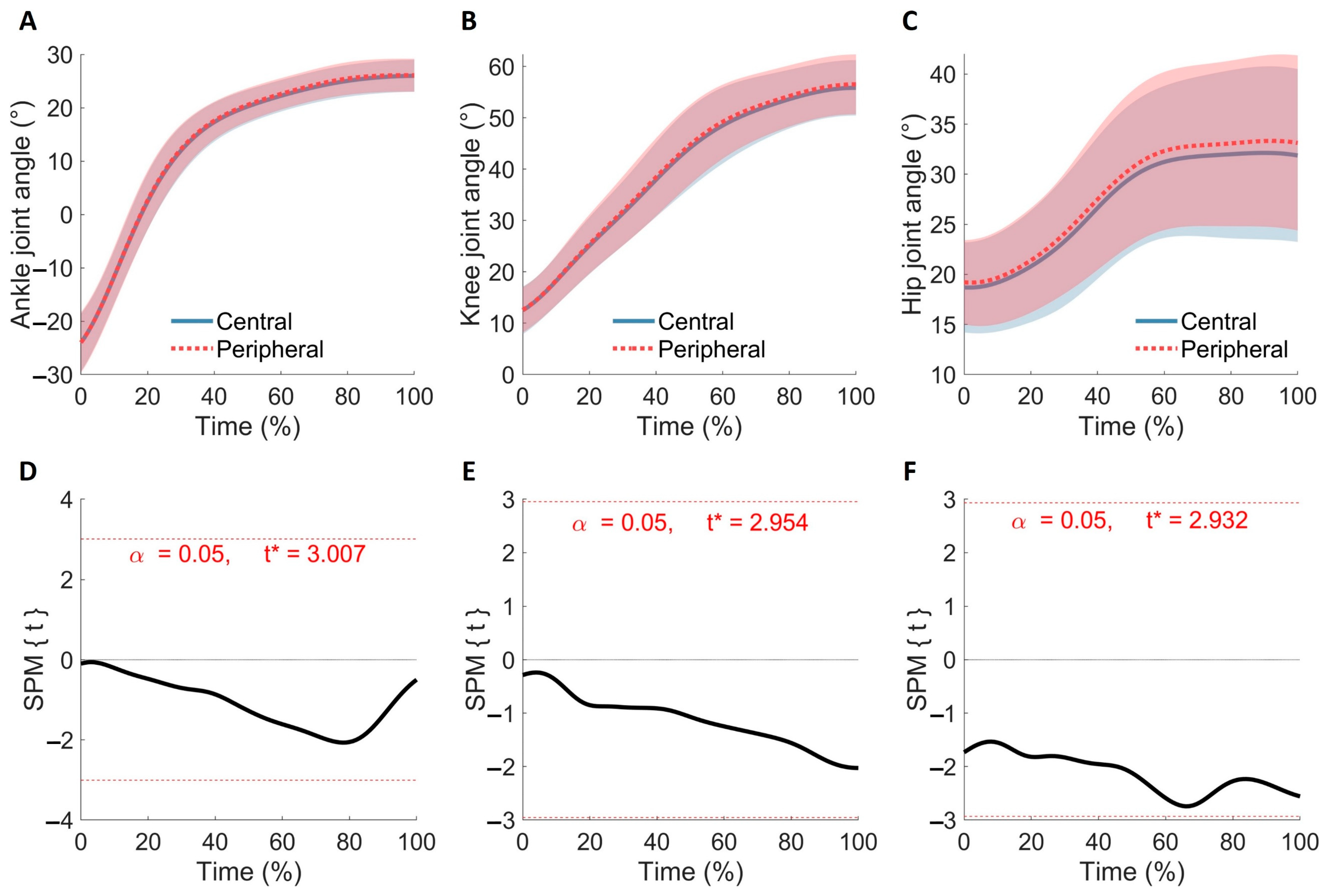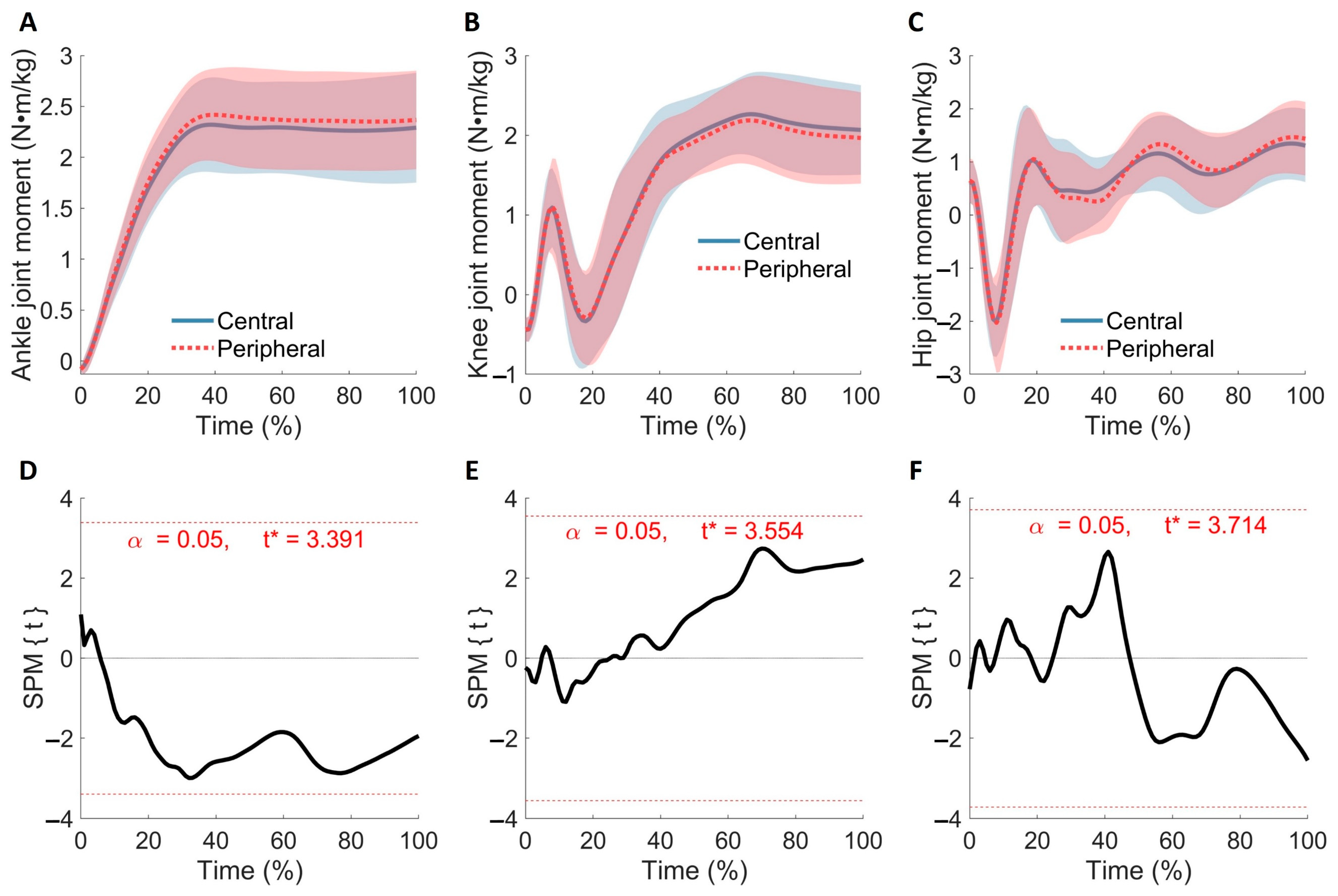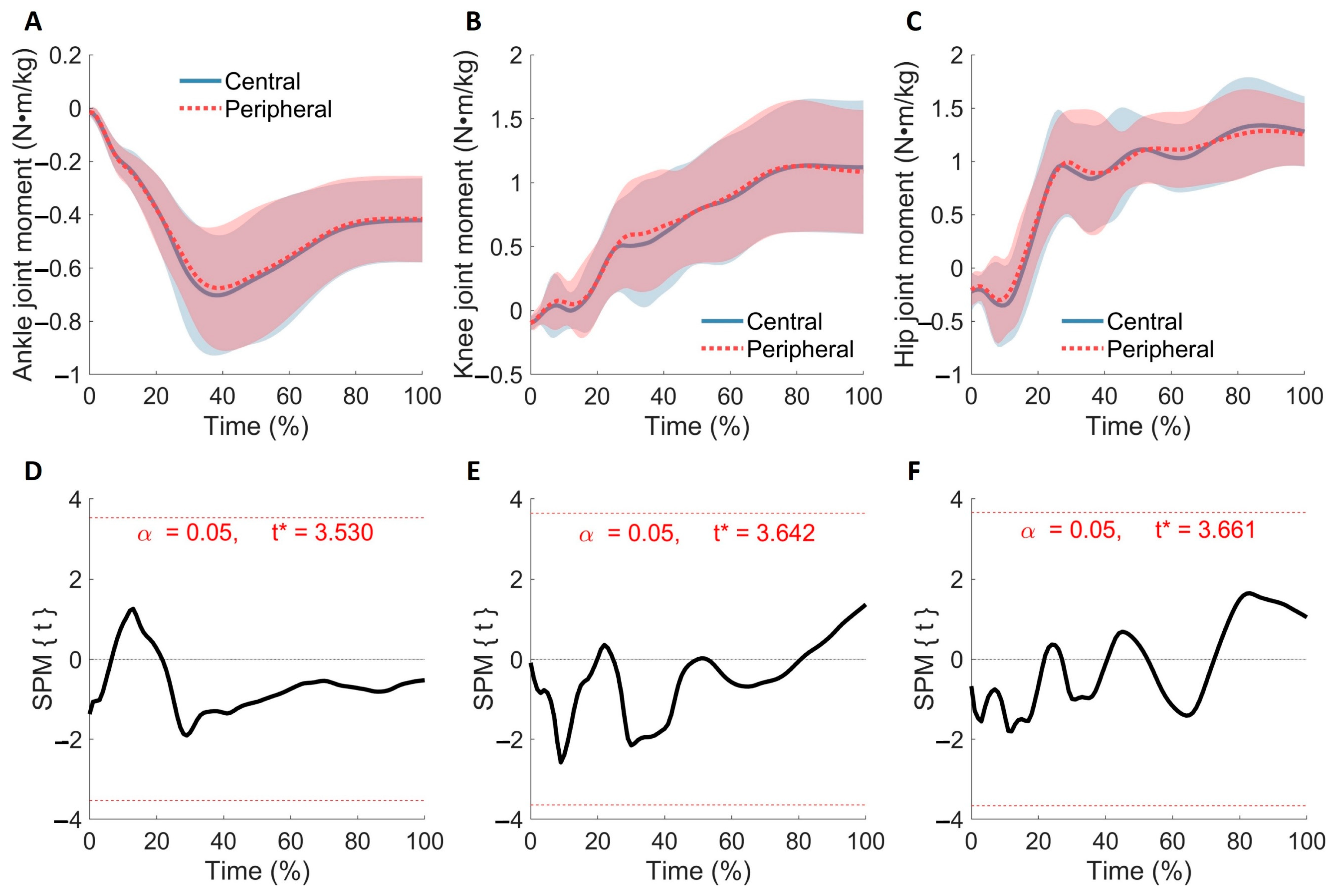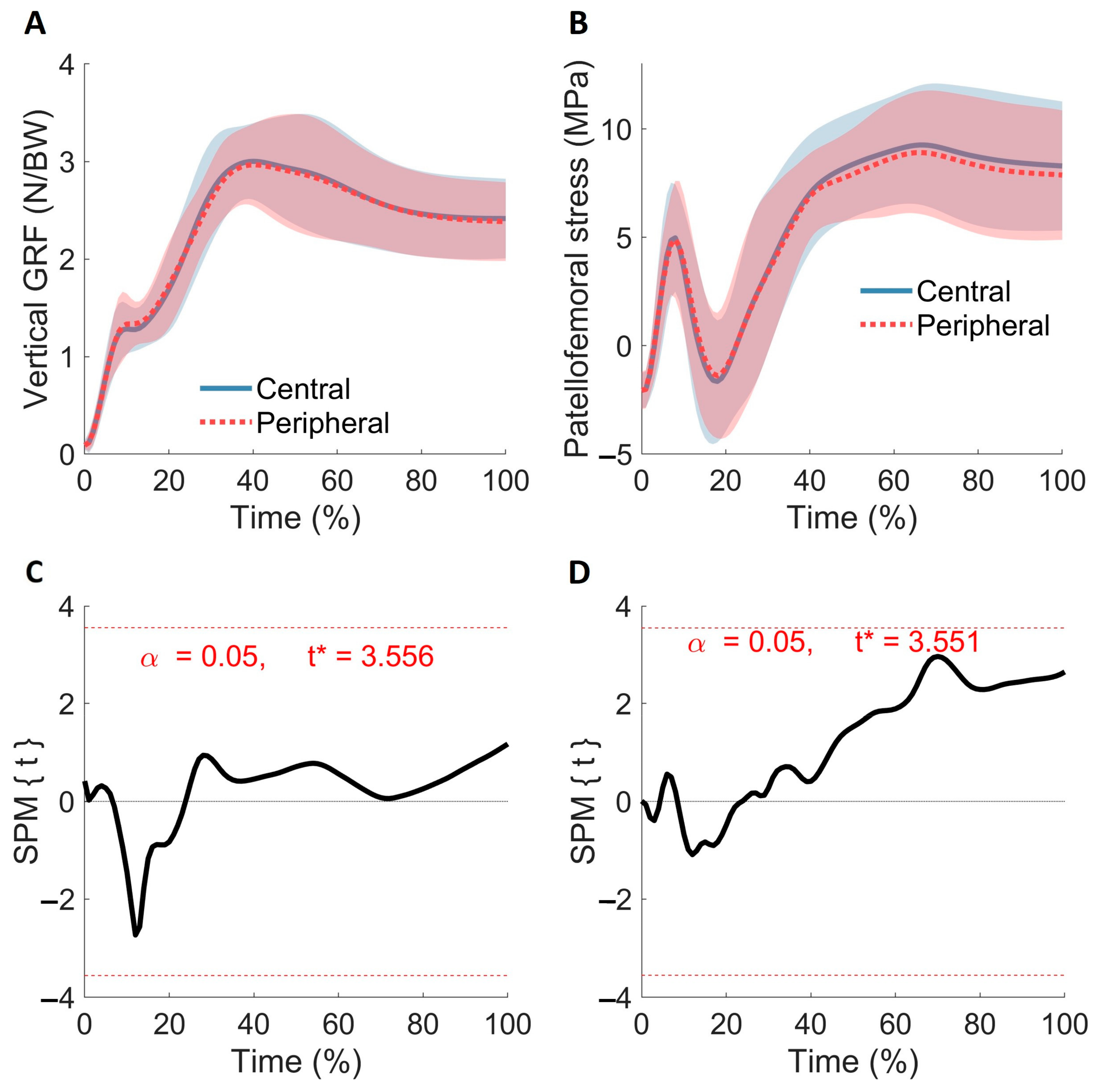Central vs. Peripheral Vision during a Singe-Leg Drop Jump: Implications of Dynamics and Patellofemoral Joint Stress
Abstract
:1. Introduction
2. Methods
2.1. Design
2.2. Participants
2.3. Procedures
2.4. Data Collection and Reduction
2.5. Statistical Analysis
3. Results
4. Discussion
5. Conclusions
Author Contributions
Funding
Institutional Review Board Statement
Informed Consent Statement
Data Availability Statement
Conflicts of Interest
References
- Fong, D.T.; Chan, Y.Y.; Mok, K.M.; Yung, P.S.; Chan, K.M. Understanding acute ankle ligamentous sprain injury in sports. Sports Med. Arthrosc. Rehabil. Ther. Technol. 2009, 1, 14. [Google Scholar] [CrossRef] [Green Version]
- Koga, H.; Nakamae, A.; Shima, Y.; Iwasa, J.; Myklebust, G.; Engerbretsen, R.B.; Krosshaug, K. Mechanisms for noncontact anterior cruciate ligament injuries: Knee joint kinematics in 10 injury situations from female team handball and basketball. Am. J. Sports Med. 2010, 38, 2218–2225. [Google Scholar] [CrossRef] [PubMed]
- Brazen, D.M.; Todd, M.K.; Ambegaonkar, J.P.; Wunderlich, R.; Peterson, C. The effect of fatigue on landing biomechanics in single-leg drop landings. Clin. J. Sport Med. 2010, 20, 286–292. [Google Scholar] [CrossRef] [PubMed]
- Podraza, J.T.; White, S.C. Effect of knee flexion angle on ground reaction forces, knee moments and muscle co-contraction during an impact-like deceleration landing: Implications for the non-contact mechanism of ACL injury. Knee 2010, 17, 291–295. [Google Scholar] [CrossRef] [PubMed]
- Shin, C.S.; Chaudhari, A.M.; Andriacchi, T.P. Valgus plus internal rotation moments increase anterior cruciate ligament strain more than either alone. Med. Sci. Sports Exerc. 2011, 43, 1484–1491. [Google Scholar] [CrossRef] [PubMed]
- Bisseling, R.W.; Hof, A.L.; Bredeweg, S.W.; Zwerver, J.; Mulder, T. Are the take-off and landing phase dynamics of the volleyball spike jump related to patellar tendinopathy? Br. J. Sports. Med. 2008, 42, 483–489. [Google Scholar] [CrossRef] [Green Version]
- Nunes, G.S.; Barton, C.J.; Serrão, F.V. Females with patellofemoral pain have impaired impact absorption during a single-legged drop vertical jump. Gait Posture 2019, 68, 346–351. [Google Scholar] [CrossRef]
- Terada, M.; Gribble, P.A. Jump landing biomechanics during a laboratory recorded recurrent ankle sprain. Foot Ankle Int. 2015, 36, 842–848. [Google Scholar] [CrossRef] [PubMed]
- Simpson, J.D.; Stewart, E.M.; Rendos, N.K.; Cosio-Lima, L.K.; Wilson, S.J.; Macias, D.M.; Chander, H.; Kinght, A.C. Anticipating ankle inversion perturbations during a single-leg drop landing alters ankle joint and impact kinetics. Hum. Mov. Sci. 2019, 66, 22–30. [Google Scholar] [CrossRef]
- Harkey, M.S.; Blackburn, J.T.; Hackney, A.C.; Lewek, M.D.; Schmitz, R.J.; Nissman, D.; Pietrosimone, B. Comprehensively assessing the acute femoral cartilage response and recovery after walking and drop-landing: An ultrasonographic study. Ultrasound Med. Biol. 2018, 44, 311–320. [Google Scholar] [CrossRef]
- Riemann, B.L.; Lephart, S.M. The sensorimotor system, part I: The physiologic basis of functional joint stability. J. Athl. Train 2002, 37, 71–79. [Google Scholar] [PubMed]
- Proske, U.; Gandevia, S.C. The proprioceptive senses: Their roles in signaling body shape, body position and movement, and muscle force. Physiol. Rev. 2012, 92, 1651–1697. [Google Scholar] [CrossRef] [PubMed]
- Cullen, K.E. The vestibular system: Multimodal integration and encoding of self-motion for motor control. Trends Neurosci. 2012, 35, 185–196. [Google Scholar] [CrossRef] [PubMed] [Green Version]
- Horak, F.B. Postural orientation and equilibrium: What do we need to know about neural control of balance to prevent falls? Age Ageing 2006, 35 (Suppl. S2), ii7–ii11. [Google Scholar] [CrossRef] [Green Version]
- Scott, S.H.; Cluff, T.; Lowrey, C.R.; Takei, T. Feedback control during voluntary motor actions. Curr. Opin. Neurobiol. 2015, 33, 85–94. [Google Scholar] [CrossRef]
- Ostry, D.J.; Gribble, P.L. Sensory plasticity in human motor learning. Trends Neurosci. 2016, 39, 114–123. [Google Scholar] [CrossRef] [PubMed] [Green Version]
- Sarlegna, F.R.; Mutha, P.K. The influence of visual target information on the online control of movements. Vision Res. 2015, 110, 144–154. [Google Scholar] [CrossRef]
- Liebermann, D.G.; Hoffman, J.R. Timing of preparatory landing responses as a function of availability of optic flow information. J. Electromyogr. Kinesiol. 2005, 15, 120–130. [Google Scholar] [CrossRef]
- Chu, Y.; Sell, T.C.; Abt, J.P.; Nagai, T.; Deluzio, J.; McGrail, M.; Rowe, R.; Smalley, B.; Lephart, S.M. Air assault soldiers demonstrate more dangerous landing biomechanics when visual input is removed. Mil. Med. 2012, 177, 41–47. [Google Scholar] [CrossRef] [PubMed] [Green Version]
- Santello, M.; McDonagh, M.J.; Challis, J.H. Visual and non-visual control of landing movements in humans. J. Physiol. 2001, 537, 313–327. [Google Scholar] [CrossRef] [PubMed]
- Liebermann, D.G.; Goodman, D. Pre-landing muscle timing and post-landing effects of falling with continuous vision and in blindfold conditions. J. Electromyogr. Kinesiol. 2007, 17, 212–227. [Google Scholar] [CrossRef]
- Magalhães, F.H.; Goroso, D.G. Preparatory EMG activity reveals a rapid adaptation pattern in humans performing landing movements in blindfolded condition. Percept. Mot. Skills 2009, 109, 500–516. [Google Scholar] [CrossRef] [PubMed]
- Terada, M.; Ball, L.M.; Pietrosimone, B.G.; Gribble, P.A. Altered visual focus on sensorimotor control in people with chronic ankle instability. J. Sports Sci. 2016, 34, 171–180. [Google Scholar] [CrossRef]
- Taylor, J.B.; Ford, K.R.; Nguyen, A.D.; Shultz, S.J. Biomechanical comparison of single- and double-leg jump landings in the sagittal and frontal plane. Orthop. J. Sports Med. 2016, 4, 2325967116655158. [Google Scholar] [CrossRef] [PubMed] [Green Version]
- Xu, D.; Jiang, X.; Cen, X.; Baker, J.S.; Gu, Y. Single-leg landings following a volleyball spike may increase the risk of anterior cruciate ligament injury more than landing on both-legs. Appl. Sci. 2021, 11, 130. [Google Scholar] [CrossRef]
- Yeow, C.H.; Lee, P.V.S.; Goh, J.C.H. An investigation of lower extremity energy dissipation strategies during single-leg and double-leg landing based on sagittal and frontal plane biomechanics. Hum. Mov. Sci. 2011, 30, 624–635. [Google Scholar] [CrossRef] [PubMed]
- Bates, N.A.; Schilaty, N.D.; Ueno, R.; Hewett, T.E. Timing of strain response of the ACL and MCL relative to impulse delivery during simulated landings leading up to ACL failure. J. Appl. Biomech. 2020, 36, 148–155. [Google Scholar] [CrossRef] [PubMed]
- Krosshaug, T.; Nakamae, A.; Boden, B.P.; Engerbretsen, L.; Smith, G.; Slauterbeck, J.R.; Hewett, T.E.; Bahr, R. Mechanisms of anterior cruciate ligament injury in basketball: Video analysis of 39 cases. Am. J. Sports Med. 2007, 35, 359–367. [Google Scholar] [CrossRef]
- Shin, C.S.; Chaudhari, A.M.; Andriacchi, T.P. The influence of deceleration forces on ACL strain during single-leg landing: A simulation study. J. Biomech. 2007, 40, 1145–1152. [Google Scholar] [CrossRef] [PubMed]
- Brechter, J.H.; Powers, C.M. Patellofemoral stress during walking in persons with and without patellofemoral pain. Med. Sci. Sports Exerc. 2002, 34, 1582–1593. [Google Scholar] [CrossRef] [PubMed]
- Farrokhi, S.; Keyak, J.H.; Powers, C.M. Individuals with patellofemoral pain exhibit greater patellofemoral joint stress: A finite element analysis study. Osteoarthr. Cartil. 2011, 19, 287–294. [Google Scholar] [CrossRef] [Green Version]
- Glaviano, N.R.; Kew, M.; Hart, J.M.; Saliba, S. Demographic and epidemiological trends in patellofemoral pain. Int. J. Sports Phys. Ther. 2015, 10, 281–290. [Google Scholar] [PubMed]
- Schmid, S.; Moffat, M.; Gutierrez, G.M. Effect of knee joint cooling on the electromyographic activity of lower extremity muscles during a plyometric exercise. J. Electromyogr. Kinesiol. 2010, 20, 1075–1081. [Google Scholar] [CrossRef]
- Park, J.; Song, K.; Lee, S.Y.; Ryu, H. Ankle Joint Cooling did not but knee joint Cooling altered the quadriceps and gastrocnemius neuromuscular Activation during a Single-leg Drop Jump. Exerc. Sci. 2020, 29, 225–232. [Google Scholar] [CrossRef]
- Jackson, K.M. Fitting of mathematical functions to biomechanical data. IEEE Trans. Biomed. Eng. 1979, 26, 122–124. [Google Scholar] [CrossRef] [PubMed]
- Blackburn, J.T.; Padua, D.A. Sagittal-plane trunk position, landing forces, and quadriceps electromyographic activity. J. Athl. Train. 2009, 44, 174–179. [Google Scholar] [CrossRef] [Green Version]
- Van Eijden, T.M.G.J.; Kouwenhoven, E.; Verburg, J.; Weijs, W.A. A mathematical model of the patellofemoral joint. J. Biomech. 1986, 19, 219–229. [Google Scholar] [CrossRef]
- Connolly, K.D.; Ronsky, J.L.; Westover, L.M.; Küpper, J.C.; Frayne, R. Differences in patellofemoral contact mechanics associated with patellofemoral pain syndrome. J. Biomech. 2009, 42, 2802–2807. [Google Scholar] [CrossRef]
- Pataky, T.C. Generalized n-dimensional biomechanical field analysis using statistical parametric mapping. J. Biomech. 2010, 43, 1976–1982. [Google Scholar] [CrossRef]
- Norcross, M.F.; Lewek, M.D.; Padua, D.A.; Shultz, S.J.; Weinhold, P.S.; Blackburn, J.T. Lower extremity energy absorption and biomechanics during landing, part I: Sagittal-plane energy absorption analyses. J. Athl. Train. 2013, 48, 748–756. [Google Scholar] [CrossRef] [PubMed] [Green Version]
- Peng, H.T. Changes in biomechanical properties during drop jumps of incremental height. J. Strength Cond. Res. 2011, 25, 2510–2518. [Google Scholar] [CrossRef] [PubMed]
- Miall, R.C.; Kitchen, N.M.; Nam, S.H.; Lefumat, H.; Renault, A.G.; Ørstavik, K.; Cole, J.D.; Sarlegna, F.R. Proprioceptive loss and the perception, control and learning of arm movements in humans: Evidence from sensory neuronopathy. Exp. Brain Res. 2018, 236, 2137–2155. [Google Scholar] [CrossRef] [PubMed] [Green Version]
- Lefumat, H.Z.; Vercher, J.L.; Maill, R.C.; Cole, J.; Buloup, F.; Bringoux, L.; Bourdin, C.; Sarlegna, F.R. To transfer or not to transfer? Kinematics and laterality quotient predict interlimb transfer of motor learning. J. Neurophysiol. 2015, 114, 2764–2774. [Google Scholar] [CrossRef] [PubMed] [Green Version]
- Chen, H.Y.; Chang, H.Y.; Ju, Y.Y.; Tsao, H.T. Superior short-term learning effect of visual and sensory organisation ability when sensory information is unreliable in adolescent rhythmic gymnasts. J. Sports Sci. 2017, 35, 1197–1203. [Google Scholar] [CrossRef] [PubMed]
- Franklin, D.W.; So, U.; Burdet, E.; Kawato, M. Visual feedback is not necessary for the learning of novel dynamics. PLoS ONE 2007, 2, e1336. [Google Scholar] [CrossRef] [PubMed]
- Buckwalter, J.A.; Anderson, D.D.; Brown, T.D.; Tochigi, Y.; Martin, J.A. The roles of mechanical stresses in the pathogenesis of osteoarthritis: Implications for treatment of joint injuries. Cartilage 2013, 4, 286–294. [Google Scholar] [CrossRef] [PubMed]
- Waiteman, M.C.; Briani, R.V.; Pazzinatto, M.F.; Ferreira, A.S.; Ferrari, D.; de Olivia Silva, D.; de Azevedo, F.M. Relationship between knee abduction moment with patellofemoral joint reaction force, stress and self-reported pain during stair descent in women with patellofemoral pain. Clin. Biomech. 2018, 59, 110–116. [Google Scholar] [CrossRef] [PubMed]
- Powers, C.M.; Ho, K.Y.; Chen, Y.J.; Souza, R.B.; Farrokhi, S. Patellofemoral joint stress during weight-bearing and non-weight-bearing quadriceps exercises. J. Orthop. Sports Phys. Ther. 2014, 44, 320–327. [Google Scholar] [CrossRef] [Green Version]
- Escamilla, R.F.; Zheng, N.; Macleod, T.D.; Edwards, W.B.; Imamura, R.; Hreljac, A.; Fleisig, G.S.; Wilk, K.E.; Moorman, C.T., 3rd; Andrews, J.R. Patellofemoral joint force and stress during the wall squat and one-leg squat. Med. Sci. Sports Exerc. 2009, 41, 879–888. [Google Scholar] [CrossRef]
- Escamilla, R.F.; Zheng, N.; MacLeod, T.D.; Edwards, W.B.; Hreljac, A.; Fleisig, G.S.; Wilk, K.E.; Moorman, C.T., 3rd; Imamura, R.; Andrews, J.R. Patellofemoral joint force and stress between a short- and long-step forward lunge. J. Orthop. Sports Phys. Ther. 2008, 38, 681–690. [Google Scholar] [CrossRef] [PubMed]
- Ristow, A.; Besch, M.; Rutherford, D.; Kernozek, T.W. Patellofemoral joint loading during single-leg hopping exercises. J. Sport Rehabil. 2020, 29, 1131–1136. [Google Scholar] [CrossRef] [PubMed]
- Wallace, D.A.; Salem, G.J.; Salinas, R.; Powers, C.M. Patellofemoral joint kinetics while squatting with and without an external load. J. Orthop. Sports Phys. Ther. 2002, 32, 141–148. [Google Scholar] [CrossRef] [PubMed] [Green Version]
- Aizawa, J.; Hirohata, K.; Ohji, S.; Ohmi, T.; Yagishita, K. Limb-dominance and gender differences in the ground reaction force during single-leg lateral jump-landings. J. Phys. Ther. Sci. 2018, 30, 387–392. [Google Scholar] [CrossRef] [PubMed] [Green Version]
- Russell, K.A.; Palmieri, R.M.; Zinder, S.M.; Ingersoll, C.D. Sex differences in valgus knee angle during a single-leg drop jump. J. Athl. Train. 2006, 41, 166–171. [Google Scholar] [PubMed]
- Leppänen, M.; Pasanen, K.; Kujala, U.M.; Vasankari, T.; Kannus, P.; Äyrämö, S.; Kroshaug, T.; Bahr, R.; Avela, R.; Perttunen, J.; et al. Stiff landings are associated with increased ACL injury risk in young female basketball and floorball players. Am. J. Sports Med. 2017, 45, 386–393. [Google Scholar] [CrossRef]
- Kim, N.; Browning, R.C.; Lerner, Z.F. The effects of pediatric obesity on patellofemoral joint contact force during walking. Gait Posture 2019, 73, 209–214. [Google Scholar] [CrossRef]
- Dicus, J.R.; Seegmiller, J.G. Unanticipated ankle inversions are significantly different from anticipated ankle inversions during drop landings: Overcoming anticipation bias. J. Appl. Biomech. 2012, 28, 148–155. [Google Scholar] [CrossRef]





| Equation # | Discription |
|---|---|
| 1 | Lever arm = 0.8E-8x3 − 0.129E-7x2 + 0.28E-5x + 0.462 x = tibiofemoral joint angle (deg) |
| 2 | Quadriceps Force (N) = knee extension moment (N·m)/lever arm |
| 3 | k = (4.62E-1 + 1.47E-3x − 3.84E-5x2)/(1 − 1.62E-2x + 1.55E-4x2 − 6.98E-7x3) |
| 4 | Patellofemoral joint reaction force (N) = k × quadriceps force |
| 5 | Patellofemoral joint contact area (mm2) = 0.0781x2 + 0.6763x + 151.75 |
| 6 | Patellofemoral joint stress (MPa) = patellofemoral joint reaction force/patellofemoral joint contact area |
| Landing Condition | Time to Peak Knee Flexion |
|---|---|
| Central vision | 0.162 ± 0.019 ms |
| Peripheral vision | 0.169 ± 0.022 ms |
Publisher’s Note: MDPI stays neutral with regard to jurisdictional claims in published maps and institutional affiliations. |
© 2022 by the authors. Licensee MDPI, Basel, Switzerland. This article is an open access article distributed under the terms and conditions of the Creative Commons Attribution (CC BY) license (https://creativecommons.org/licenses/by/4.0/).
Share and Cite
Ko, J.; Song, K.; Kim, H.; Lee, S.Y.; Park, J. Central vs. Peripheral Vision during a Singe-Leg Drop Jump: Implications of Dynamics and Patellofemoral Joint Stress. Appl. Sci. 2022, 12, 2599. https://doi.org/10.3390/app12052599
Ko J, Song K, Kim H, Lee SY, Park J. Central vs. Peripheral Vision during a Singe-Leg Drop Jump: Implications of Dynamics and Patellofemoral Joint Stress. Applied Sciences. 2022; 12(5):2599. https://doi.org/10.3390/app12052599
Chicago/Turabian StyleKo, Junyoung, Kyeongtak Song, Hoon Kim, Sae Yong Lee, and Jihong Park. 2022. "Central vs. Peripheral Vision during a Singe-Leg Drop Jump: Implications of Dynamics and Patellofemoral Joint Stress" Applied Sciences 12, no. 5: 2599. https://doi.org/10.3390/app12052599
APA StyleKo, J., Song, K., Kim, H., Lee, S. Y., & Park, J. (2022). Central vs. Peripheral Vision during a Singe-Leg Drop Jump: Implications of Dynamics and Patellofemoral Joint Stress. Applied Sciences, 12(5), 2599. https://doi.org/10.3390/app12052599






